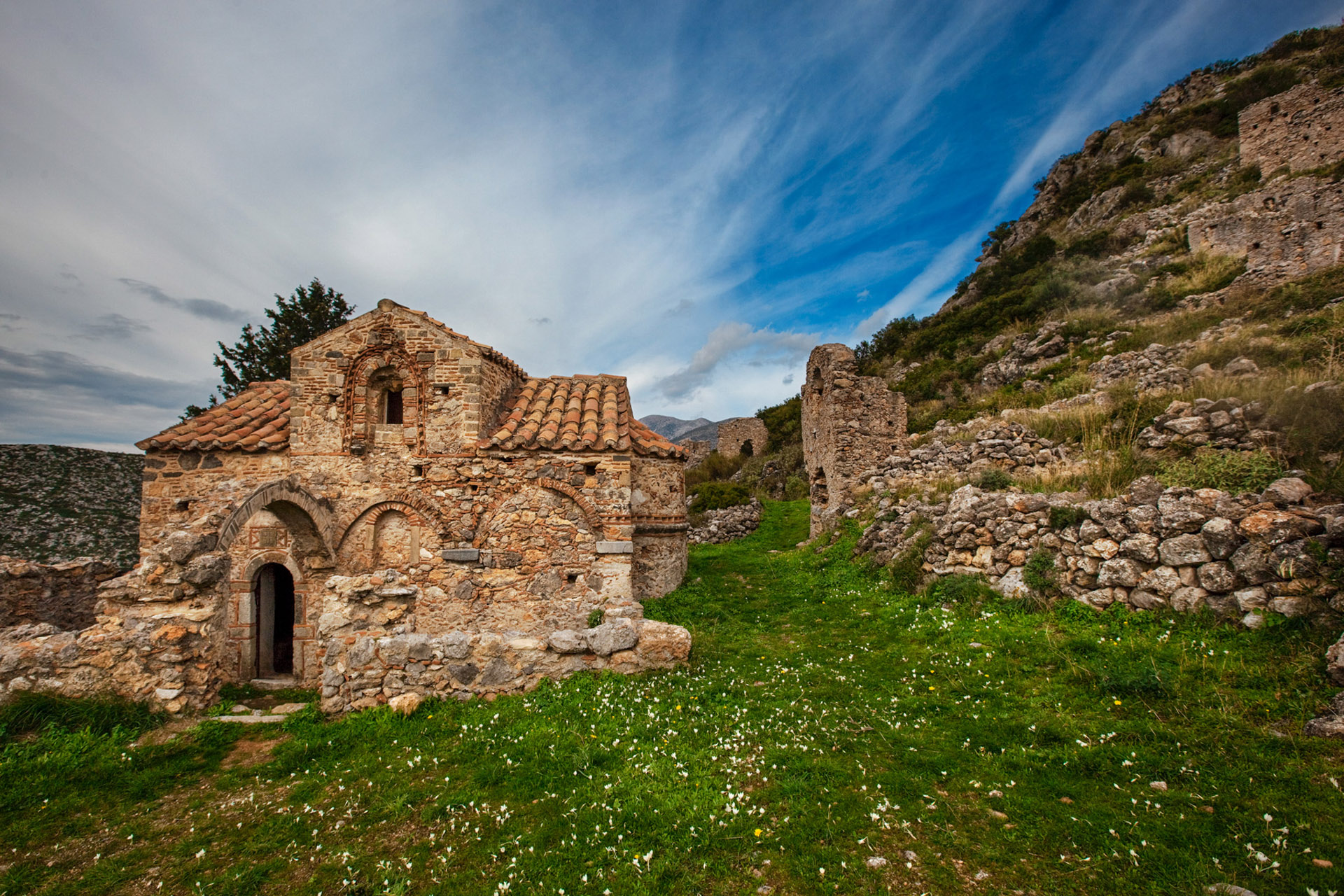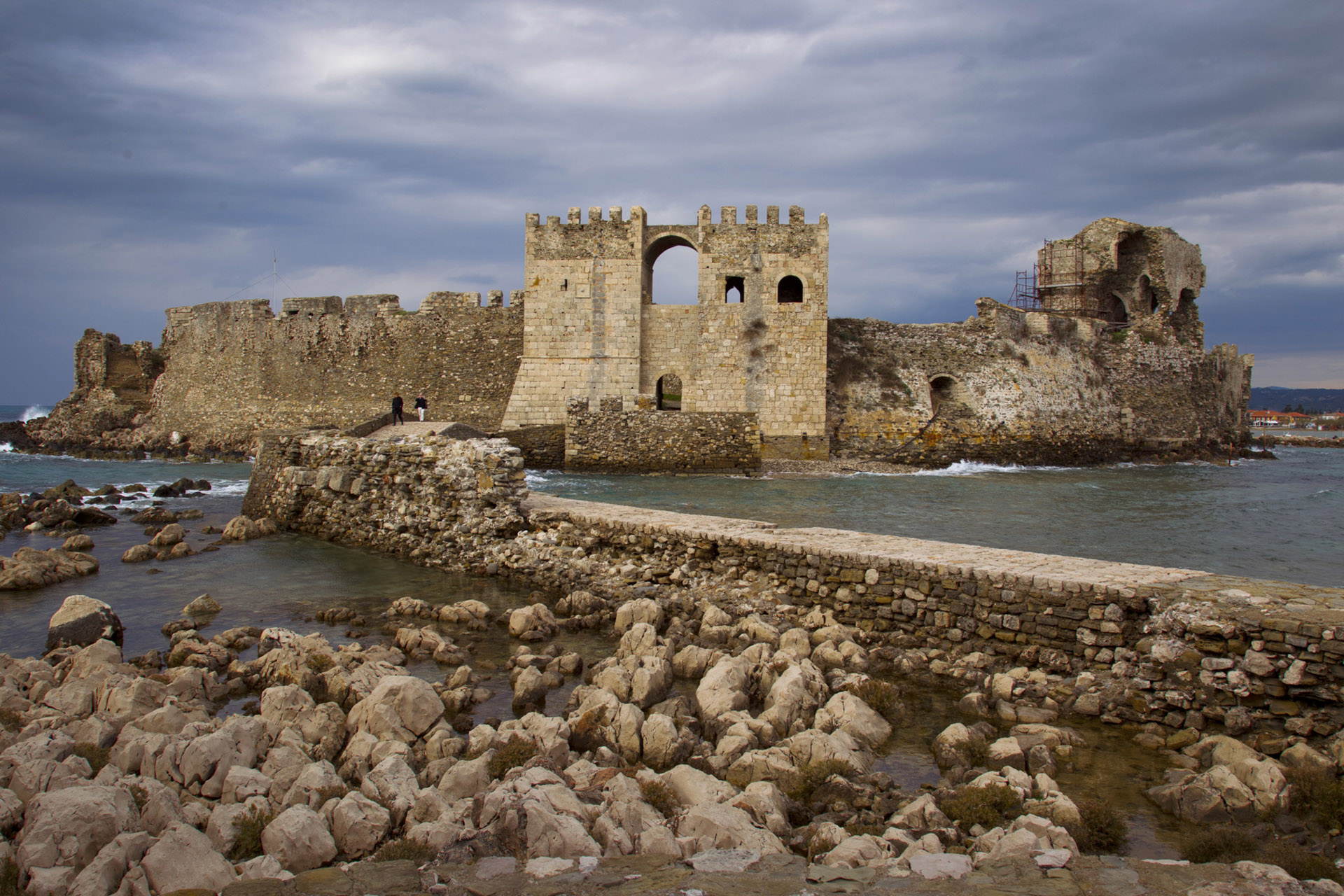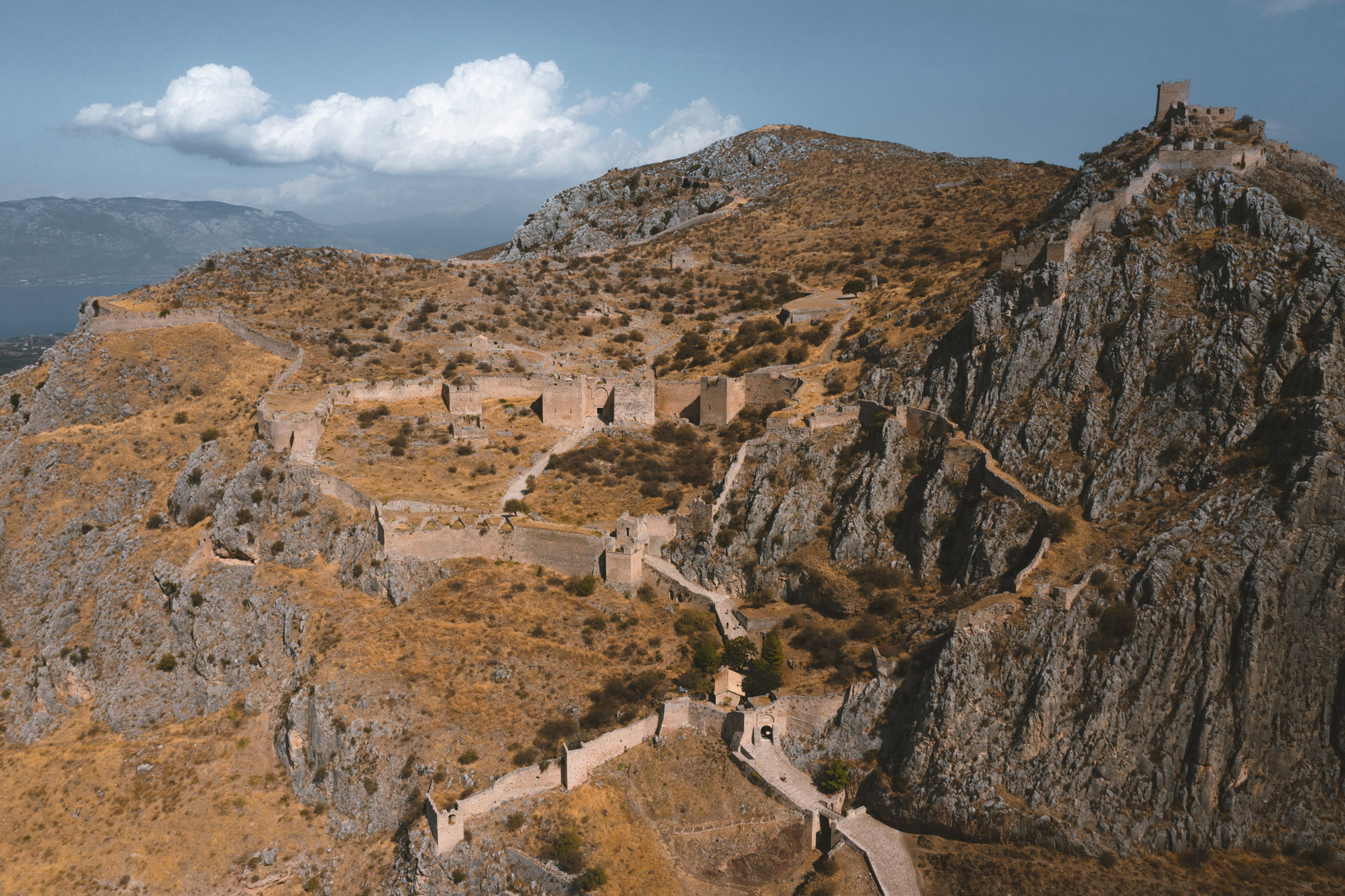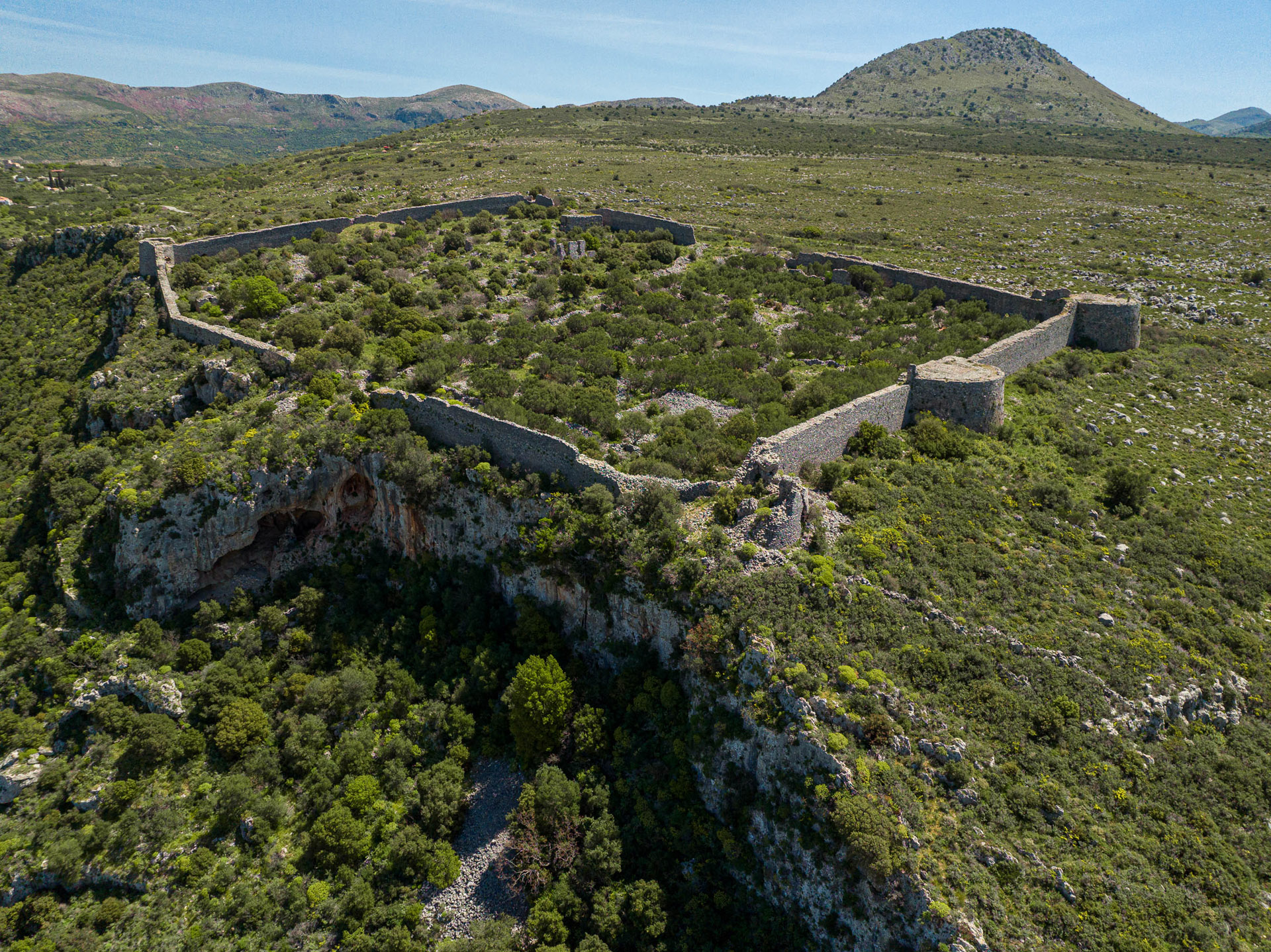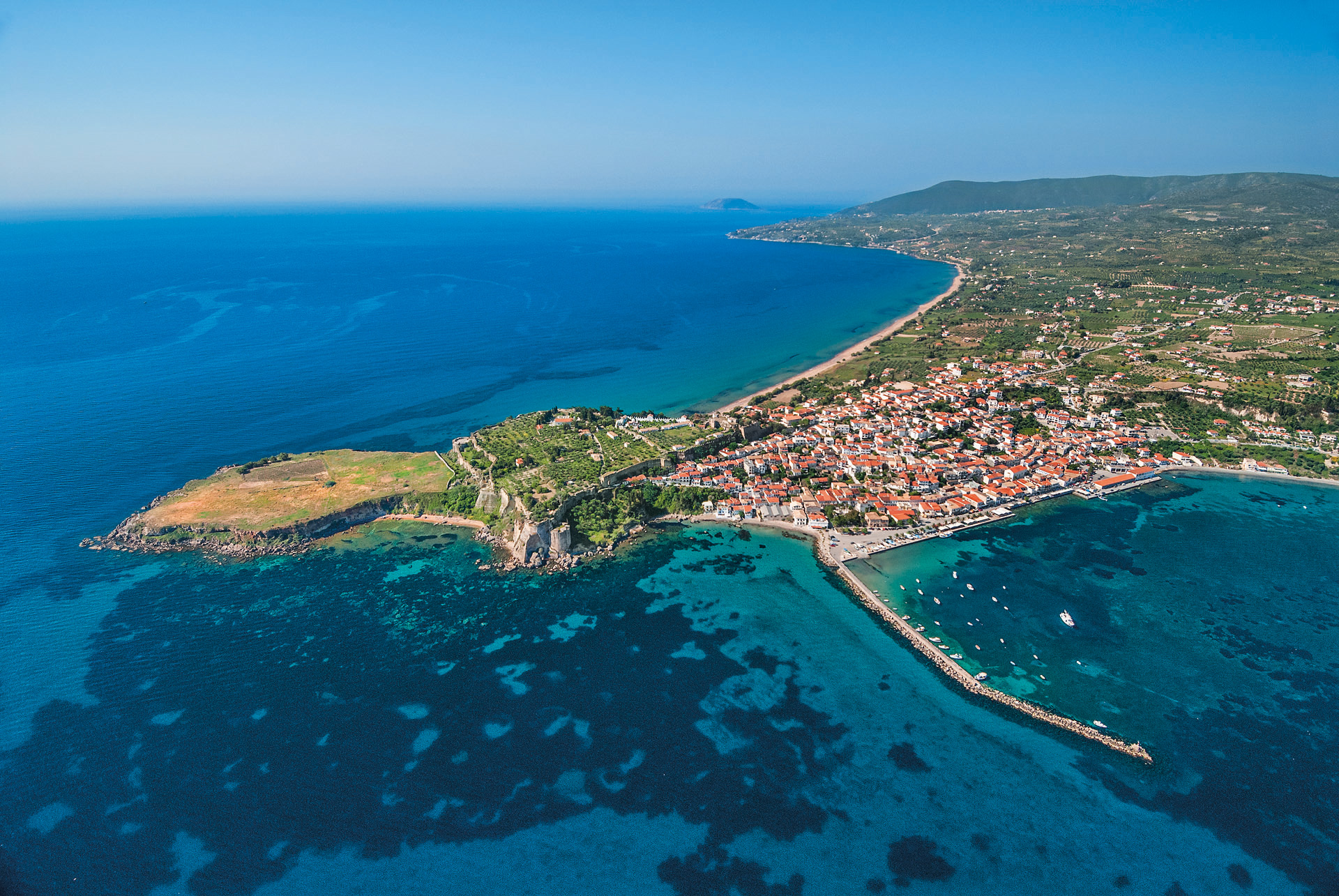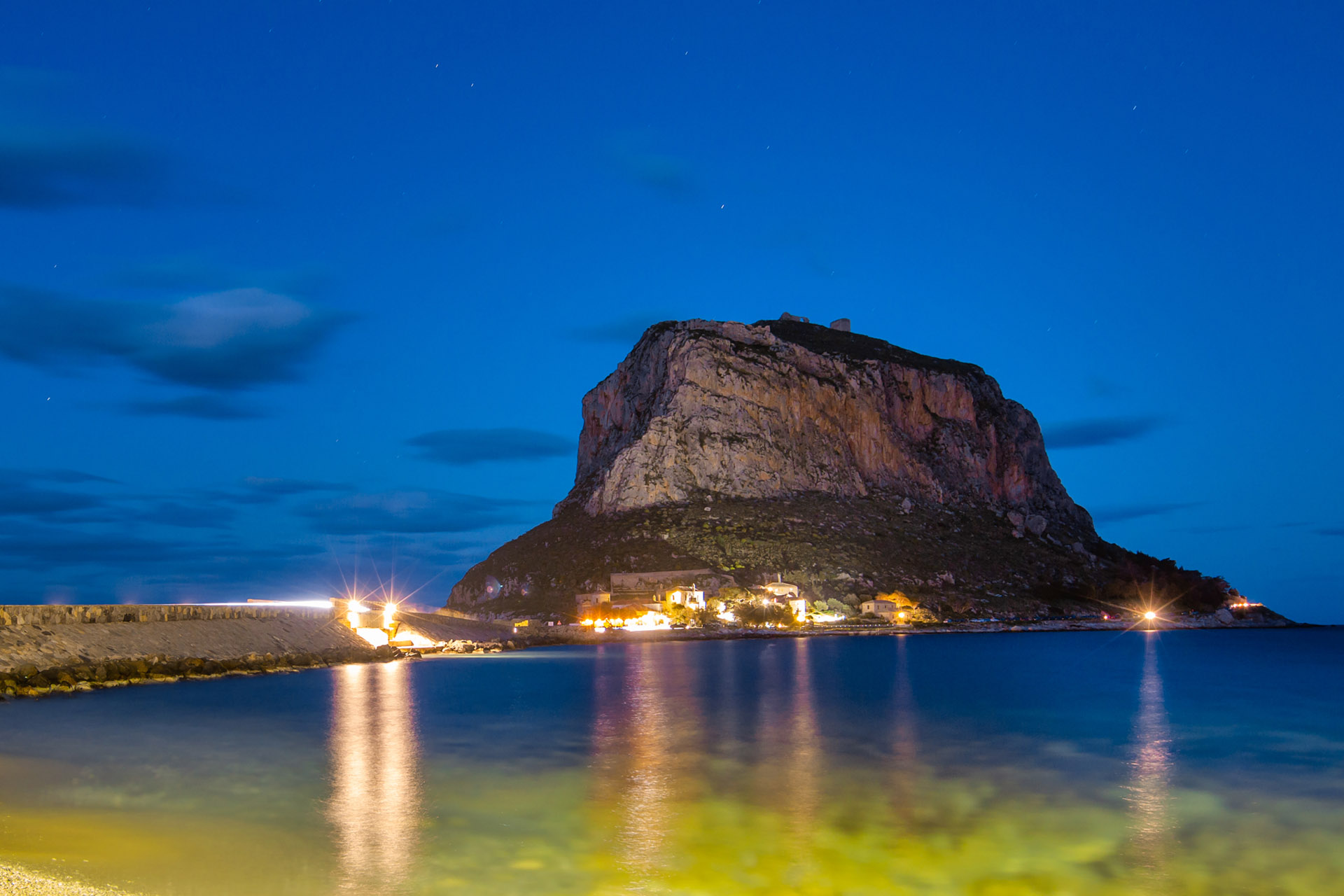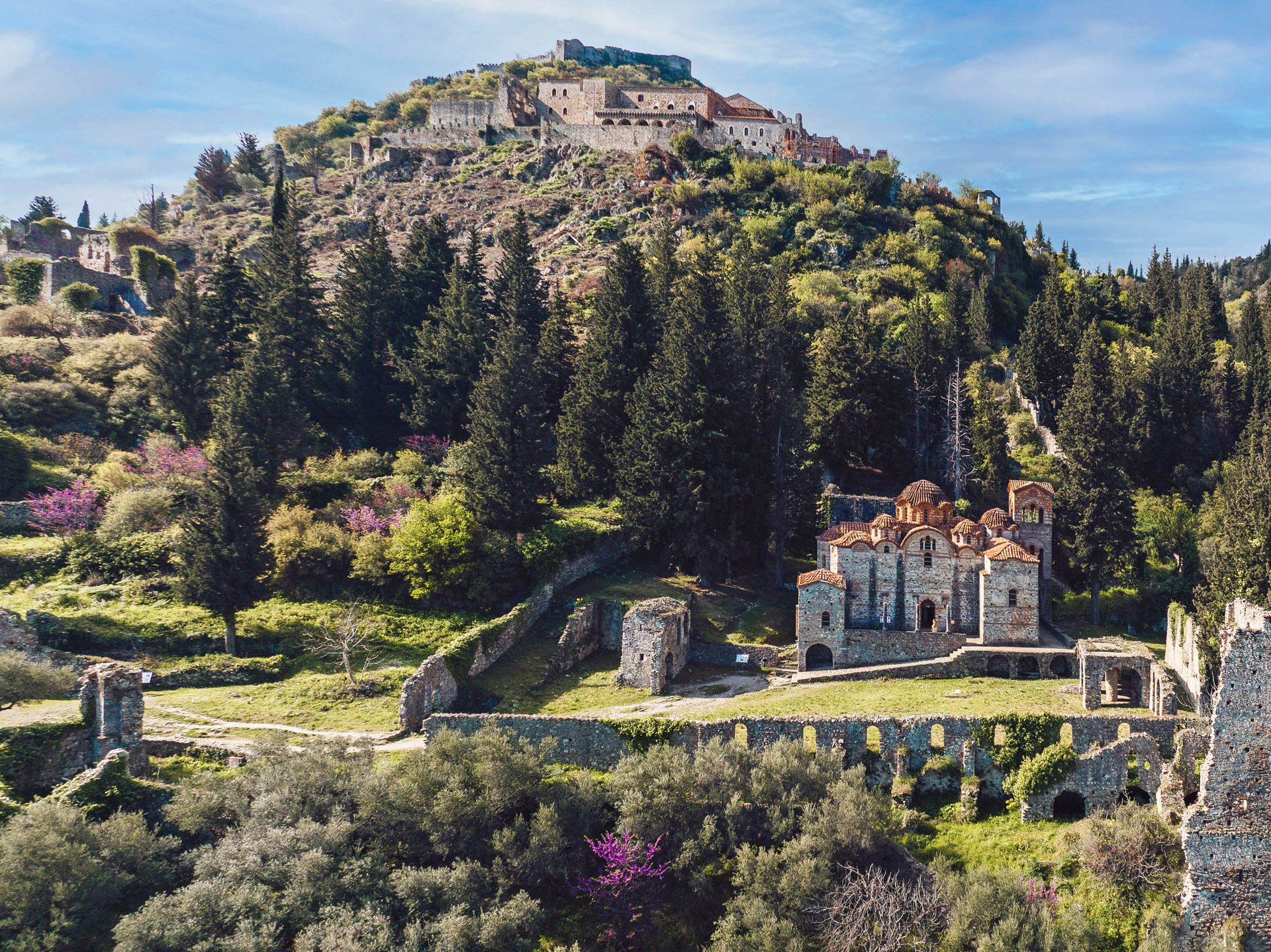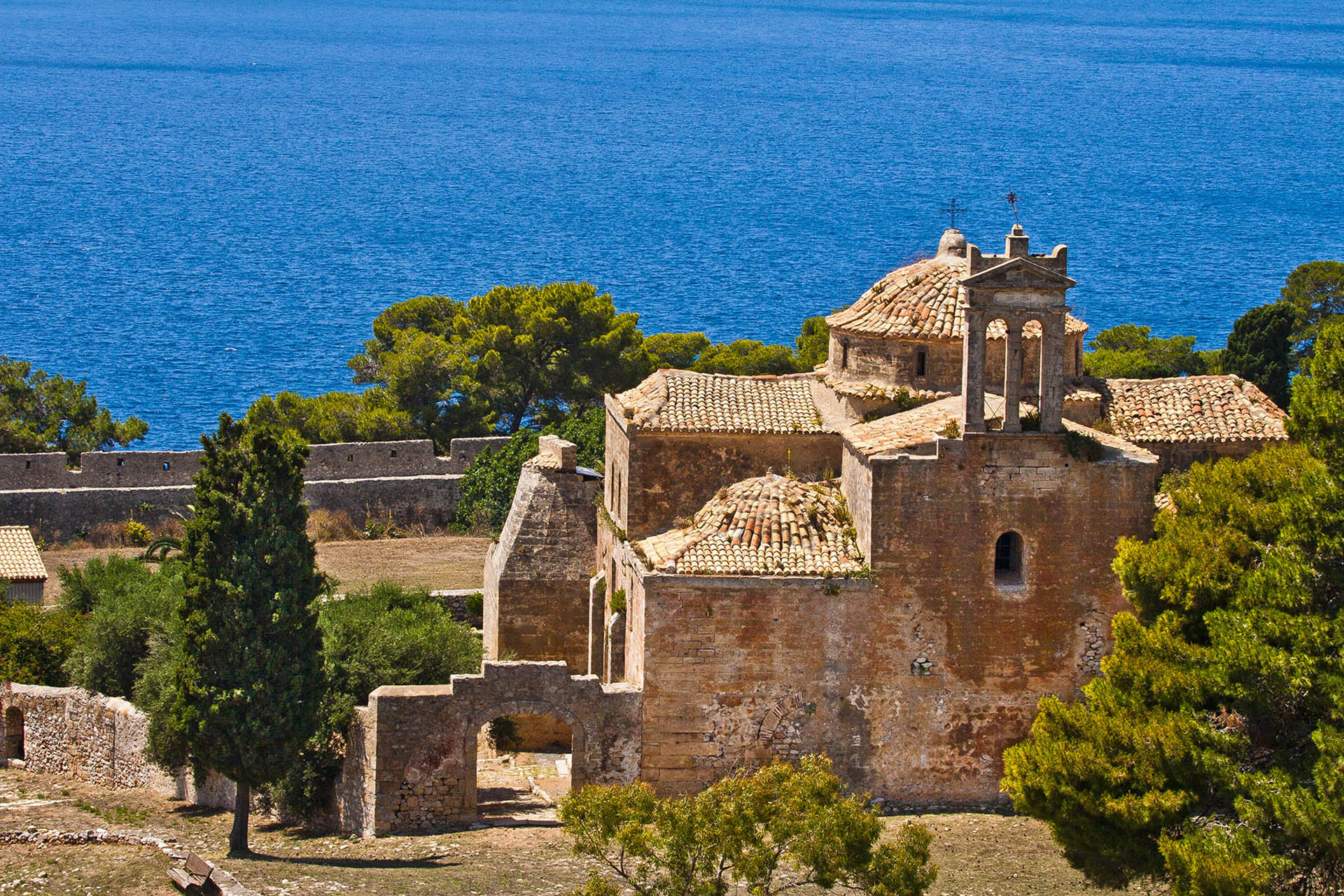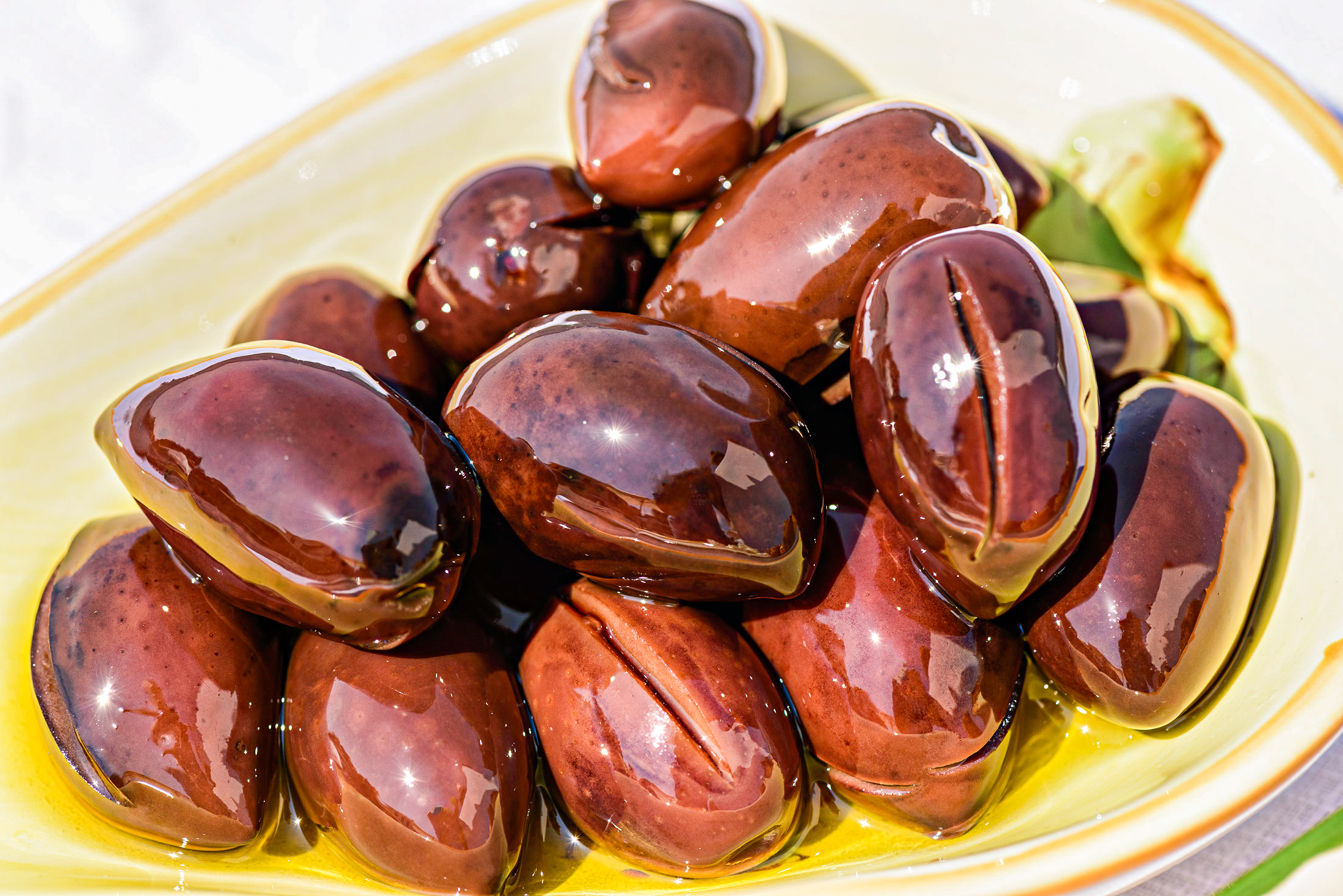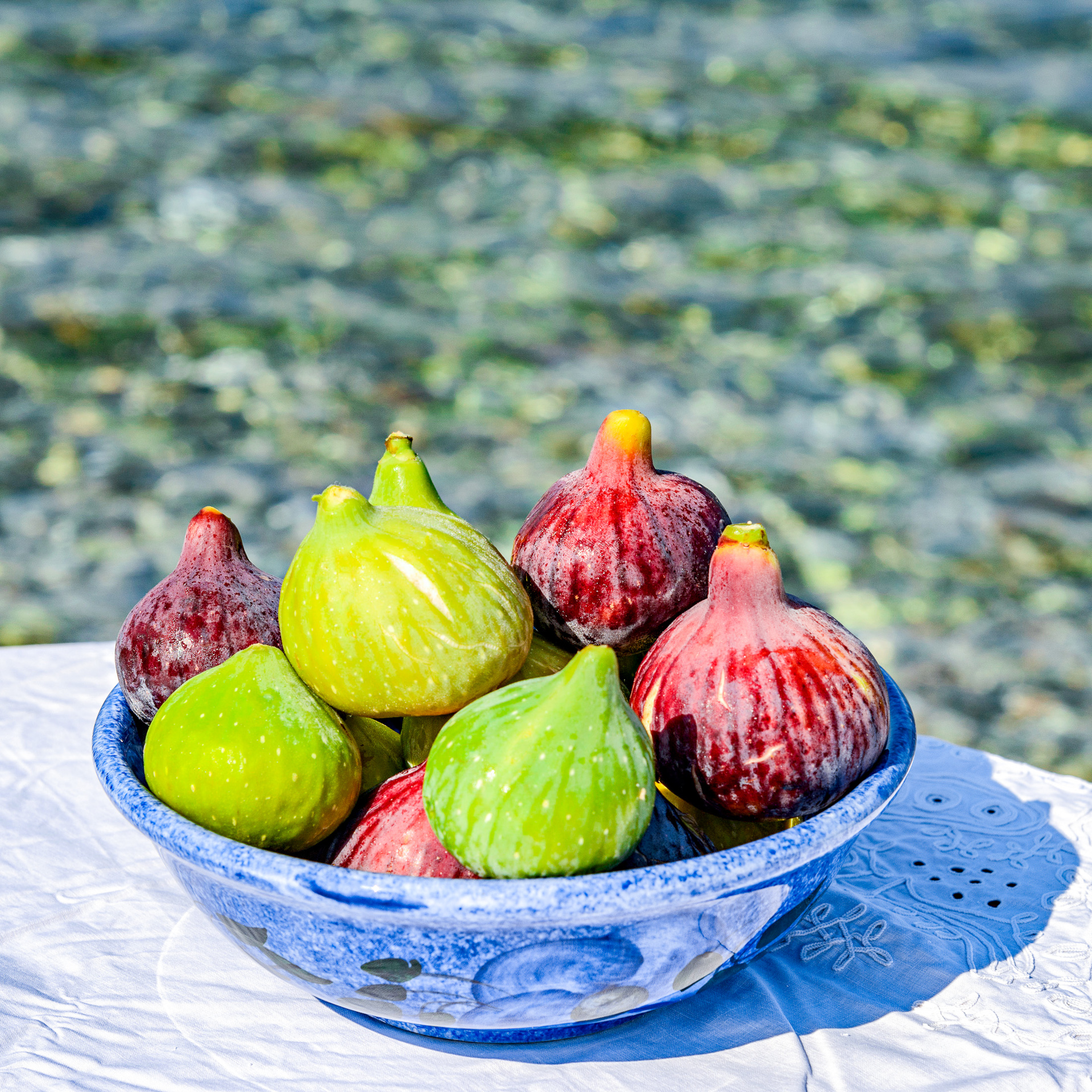TOP 10 Castles in the Peloponnese
Castles galore! Mystras, Monemvasia, Palamidi, Methoni, Koroni, Acrocorinth, Geraki, Kelefas, New Navarino Fortress in Pylos and Chlemoutsi - just some of the castles you can explore as part of your holiday.
The Peloponnese has had a turbulent history, with the Romans, the Venetians, the Crusaders, the Ottomans and the Byzantines all occupying various different parts of the peninsula at various different times. Of course, they all had to defend their conquests against attackers, so they built castles and fortified enclosures at strategic locations in more or less every corner of the Peloponnese. Many of these are still standing, and indeed several have been partially or fully restored so you can see them much as they were in their heyday.
Each castle has its own character and history. Some are perched beside the sea, some are on hilltops inland, one is even on its own island! Some were built purely for military use, some include churches and mansions, and some include an entire Byzantine city state! But one thing they all have in common is a great view. The troops defending the castles had to be able to see any attackers approaching, so the builders chose their sites carefully and all the castles have panoramic views – an added bonus for today’s visitors.
So why not step back in time and set off for the ramparts, towers and bastions? You’ll enjoy a whole new understanding of Greek history, a wonderful view and an adventure that will bring you closer to all the empires and individuals who left their mark on this special part of the world.
Mystras – the Byzantine State Ruled by the Paleologos Despots
If you visit the historic castle-state of Mystras, prepare to find yourself immersed in a great Byzantine story that began in the middle of the 13th century and lasted right up until 1953 when the last inhabitants moved out.
The story begins with the stunning setting on the slopes of Mount Taygetus, and then continues with the Frankish prince William II Villeardouin who built the first castle here around 1249. However, the castle and the fortified town around it soon became the capital of the Byzantine Despotate of Mystras. It was a thriving walled city with monasteries, churches, chapels, houses and palaces, and you can still see the remains of these today as you make your way through what used to be bustling Byzantine streets.
The city was ruled by the Paleologos family and was home to a movement known as the Palaeologean Renaissance. This cultural shift came to the fore under Constantine I Paleologos. Philosophy and art flourished and many thinkers, artists and historians, including the famous philosopher Gemistos Plethon, lived in the city.
The upper area in the site “Ano Chora” is dominated by the Palace - the only surviving Byzantine palatial complex in Greece. Look out for the impressive Throne room, where the city’s rulers, known as Despots, were crowned.
Mystras is also famous for its late Byzantine churches which are scattered throughout the archaeological site. Some of the most interesting are:
- The Church of the Hodegetria with its imposing arches, aisles and tower-shaped chapels which were built in the 14th century and are on a par with those in the great churches of Constantinople. The tomb of Theodore I Paleologos who was Despot of Morea is in one of the chapels.
- Agios Dimitrios, where in 1449 the coronation of Constantine Palaeologus took place. He was to become the last emperor of Byzantium and fell fighting on the walls of Constantinople during the siege by the Ottomans. Since then he has been associated with the legends of the "Marble King" who is waiting for the call to come back to life and retake Constantinople.
- The Pantanassa monastery which dates from 1428 and which is still inhabited today. The frescos are some of the last examples of Byzantine art.
Palamidi, Nafplion’s protector
Palamidi Castle, which keeps watch over the city of Nafplion, is the largest and best-preserved Venetian castle in Greece. It’s well worth a visit with lots to see and explore, and of course the views are amazing!
The palace is named after the Homeric hero, Palamedes, who fought with the Greeks in the Trojan war. The Venetians occupied the site in 1686, when General Morosini first came up with the idea of building a castle up on the rock. It took a while to get started, but once the building work began in 1711 it only took three years to finish the whole fortress. All in all, it is a masterpiece of fortress architecture with a defence system which relied on eight tiered, mutually supporting bastions connected by walls. However the Venetians didn’t have much time to admire their handiwork as a year later the fortress fell to the Ottomans in the siege of Nafplion. About a century later, in 1822, the Greeks captured the castle and liberated Nafplion from its Ottoman rulers.
THE 857 STEPS. If you're in good physical shape, try climbing the 999 steps up to the Palamidi. But if you count them carefully enough, you’ll find out there are actually “only” 857! Whatever you do, don’t get so involved in counting that you forget to look back at the glorious views. Then again, if all those steps don’t sound like fun, you can easily conserve your energy and drive up to the top.
Chlemoutsi, a masterpiece of Crusader fortress architecture
Chlemoutsi castle dominates the plain of Ilia, standing proudly on a hilltop on the westernmost cape in the Peloponnese. It has recently celebrated its 800th birthday as it was built by Godefroid I Villeardouinos between 1220-1223. However, despite its age, the castle is one of the best-preserved castles in Greece, and is an excellent example of Crusader fortress architecture. It is particularly interesting as it has not been altered a great deal since it was built – out of all the armies which occupied it over the years, only the Turks made some modifications to modernise it.
Today it covers about 15 acres, with two areas enclosed by ramparts. The inner castle keep is right on the highest point of the hill and is formed by a series of vaulted halls which surround a large courtyard. This was the residence of the castellan or prince, and the site of the reception rooms and accommodation for the garrison.
The famous castle state of Monemvasia
You could be forgiven for thinking that you’ve travelled back in time when you visit Monemvasia. It’s a world of its own – an island with narrow, cobbled lanes twisting around the stone-built houses and Byzantine churches, and views, views, and more views! Over the years, it’s been conquered by the Crusaders, the Byzantines, the Venetians and the Turks, but nowadays it’s the castle’s turn to conquer the heart of everyone who sets foot here!
Whether you stay in one of the atmospheric guesthouses on the island of Monemvasia, or just come for a day-trip, you’ll agree that this is one of the most beautiful medieval castle-states in Europe. The island is joined to the mainland by a narrow strip of land, the "moni emvasi” (only entrance) which is probably where the town got its name.
The town developed naturally, following the ups and downs and twists and turns of the landscape. Right at the top is the acropolis with its panoramic view, then the Upper Town and then the Lower Town. Most of the buildings have survived the centuries and are now restored and either lived in or rented out as holiday lets. Be sure to take a stroll through the Lower Town where you will find shops, cafes and traditional tavernas.
It is said that there were once 40 churches in Monemvasia, but today only 24 of these remain. They are mostly Byzantine, and despite the modifications carried out during the second Venetian occupation, the churches retain many original features. The oldest church is Elkomenos Christos which is thought to date back to the 6th century. It’s other claim to fame is the rare 14th century Byzantine icon of the Crucifixion of Christ in the church. Next door to it is a mosque. Now a museum, tradition tells us that this building was originally a church dedicated to the local saint, Saint Peter.
The most famous church in Monemvasia is Theotokou Odigetria -Agia Sophia- which was converted into a mosque during the Turkish occupation. It dates back to the 12th century and has excellent frescoes from the 17th century. It’s also worth keeping an eye out for Panagia Chrysafitissa, Panagia Kritikia (Myrtidiotissa) and Agios Nikolaos.
The spectacular Venetian castle of Methoni
No matter when you catch sight of Methoni castle, you’ll be enchanted. It’s just as spectacular in the light of the setting sun as it is at night when it’s floodlit. And of course if you are relaxing on the beach or swimming in the sea and look out over to the castle, the view seems to be straight out of a fairy-tale.
Turning to the castle’s history, it was built by the Venetians and protected an entire castle-state which flourished between the 13th and 15th centuries. It’s a large site, 93 acres in total, and it covers the entire of the SW peninsula of Methoni going up to the islet which is fortified with the famous octagonal tower.
Pylos: The impressive New Navarino fortress (Neokastro)
The new Navarino Fortress is inextricably linked to the city of Pylos, and it’s stature and position reminds us of the important role played by the area over the centuries. There is a lot to see here, an impressive church, museums, a beautiful courtyard, walls and ramparts and, of course, a spectacular view of the Bay of Navarino. The castle was built by the Ottomans in 1573 to control the southern entrance to Navarino Bay and the East-West trade sea route. Like all the castles in Messinia, it has had an “interesting life” and a starring role in events that sealed the modern history of Greece. Watch out for the Maizonos barracks with the Archaeological Museum of Pylos, and the “Pasha building” which was built between the 17th and 18th centuries and houses an exhibition of marine antiquities.
Also, make sure you visit the Transfiguration of the Saviour church which was built during the reign of Sultan Murat III as an Ottoman mosque. During Venetian rule (1686-1715) it functioned as a Catholic church and then, when the new Greek state was established, it became a Greek Orthodox church.
Acrocorinth the “omnipotent”
Acrocorinth is a wonderful mix of structures and fortifications with a history going back to Ancient Greece. It seems that the first defences were built here in the 7th and 6th century BC, and large sections of the masonry we see today date back to the 4th century BC. The Romans, the Turks, the Venetians and the Crusaders all occupied the citadel at some point, and they all repaired, added to or altered the site in one way or another. The citadel is the second oldest in Greece - after that of Athens.
Acrocorinth can be seen from miles around as it is on the top of a 575m high rocky outcrop. And of course the views from the highest point of the fortress, the temple of Aphrodite, are spectacular – in good weather you can see out to the Corinthian Gulf, the Saronic Gulf, the plain of Argos, Corinth and Central Greece.
On the northern slopes of the hill of Acrocorinthos you can visit the archaeological site of Ancient Corinth and the museum.
The castle state of Koroni, "eye of Venice"
The castle of Koroni is one of the most famous castles in Greece, and deservedly so. It covers 62 acres on a low peninsula, close to the beautiful settlement of Koroni. It’s another Venetian castle and flourished from the 13th to the 17th century. You can still see large sections of the walls which originally stretched 1200m to protect the fortifications. The castle state of Corone, as the Venetians called it, was of great strategic importance. In fact, together with the Venetian castle at Methoni, it controlled the trade routes to and from the East which gave rise to its nickname "the eye of Venice”.
The original Byzantine fortress was on the highest point where today you can see the Timiou Prodromou monastery. Not surprisingly given the castle’s role in history, there are great view out over towards the Messinian Gulf with the mountain peaks of Taygetos visible in the background.
The historic castle of Geraki
This ruined but highly atmospheric castle of Geraki (meaning hawk) was built by the Crusader, Baron Guy De Divelle, in 1209, in a commanding position in the foothills of Mount Parnon. It then fell to the Byzantines and played an important military role as signals were sent from here to the famous Byzantine castles at Mystras and Monemvasia. The architecture is similar to other mountain fortresses and there are large corner towers. Inside the walled enclosure you will see various churches such as Agios Georgios, Zoodochos Pigi and Agia Paraskevi, and there are also other churches outside the settlement, - all with frescoes dating from the 13th to the 15th century.
Kelefas Castle, the protector of Oitylo
Kelefas guards the area from its naturally fortified position above the bay of Oitylo. The castle was built in 1670 by the pirate chief and first bey (ruler) of Mani, Lymberakis Gerakaris. However, it was seized by the Ottomas who held it for 15 years until 1685 when it was handed to the Maniots and their Venetian allies who strengthened the fortifications and appointed a garrison. They remained there until 1715, but the castle had lost its strategic importance and was finally abandoned.
Today it occupies 13 acres. It is surrounded by the original walls and 2 of the 4 bastions are still in reasonable condition. You can go in through an opening in the southwest walls and explore inside the castle, but take care and make sure you’ve got suitable footwear as the site is not supervised or organised and there are no cleared and marked pathways etc. There is a wonderful view of Oitylo and the Messinian Gulf - especially at sunset.

